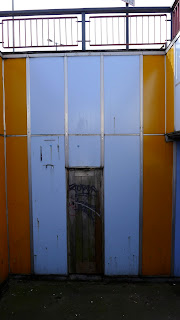PERRY BARR, MARCH 4TH 2011
Perry Barr, sounds rural, romantic or like the name of a childhood sweet, we’d never been there and we went with few preconceptions other than it was unlikely to be rural, romantic or anything like a childhood sweet!
To take advantage of our £10 Great Escape ticket we had to begin our journey at Northampton Station, a busy place but very ugly in a low, crouching, cramped kind of way. It’s a functional place with many commuters using the line to get to and from work; it must cost commuters a fortune in parking fees every week.
To take advantage of our £10 Great Escape ticket we had to begin our journey at Northampton Station, a busy place but very ugly in a low, crouching, cramped kind of way. It’s a functional place with many commuters using the line to get to and from work; it must cost commuters a fortune in parking fees every week.
On our arrival at Perry Barr we knew we were going to have to work hard to make the place come alive in our imagination, if Northampton Station was ugly, then Perry Barr really needed to be adopted by the community. The London Midland lime green and black livery did do something to add a visual cohesion but there was a sense of things being a bit run down and unloved.

Maps, help points and signage were sad, tired and there was a cherry tree that seemed to be held prisoner in the unforgiving embrace of the concrete stair-rail, there was also bird song, and budding on the branches, the light was lifting, warming and the adventure was about to begin.

Out on the street we were struck by the noise, petrol fumes and the savage gash created by the main road running through Perry Barr. It was hard to get any sense of the place, it wasn’t a space it was a line. There had been an attempt to make the Subways beautiful in an Art Deco-meets-the-8o’s way.

The community didn’t love that either; the walls were tagged, the walkways were filthy, cigarette butts and cast aside rubbish etched itself on the eye.
It was obvious that there were the beginnings of regeneration; the bold colours of a large, curved billboard jumped out at you, urging you to "Be a Star in Perry Barr". The significance of this became clear later.
As our senses began to atune to the surroundings, we started to pick out interesting details that seemed to hint at stories: a dignified Church building sitting next to a modern factory / warehouse complex. Sheltered under the ornate arch of the church entrance, a man, smartly dressed in a dark suit, texting on his iphone……….

A jumble of sudden colour at the market, bright fruity colours lined up in blocks that sang out amongst the concrete and tarmac greys of the main road.
Having almost stumbled over a monument to P. C. Malcolm Walker we stopped to puzzle over it.
A voice behind us piped up “ I can tell you all about that, what happened that day……” and Sal the manager of a Property Lettings Agency launched into the history of the monument, what had happened on the day, the subways, the tension between communities, his passion for local and family history, his travels in the forces, the wide and varied network of his family and roots. We were wide-eyed and glued to the spot and we felt it was as if we were meant to meet this person who was able to make the location come alive.
Once we started noticing the individual, whether it be in the glorious local market or the tales of Sal, we realised how friendly this place can be. Many of the people milling about were calling a good morning to others in the street, there did seem to be some sense of community and people were, on the whole, smiling. An underlying warmth in Perry Barr had started to reveal itself and we were glad we had taken the time to look deeper. As our walk around the area continued, we found more things of astonishing beauty and potential, and we left hugely inspired... which you can read about in part 2, coming soon!
A voice behind us piped up “ I can tell you all about that, what happened that day……” and Sal the manager of a Property Lettings Agency launched into the history of the monument, what had happened on the day, the subways, the tension between communities, his passion for local and family history, his travels in the forces, the wide and varied network of his family and roots. We were wide-eyed and glued to the spot and we felt it was as if we were meant to meet this person who was able to make the location come alive.
Once we started noticing the individual, whether it be in the glorious local market or the tales of Sal, we realised how friendly this place can be. Many of the people milling about were calling a good morning to others in the street, there did seem to be some sense of community and people were, on the whole, smiling. An underlying warmth in Perry Barr had started to reveal itself and we were glad we had taken the time to look deeper. As our walk around the area continued, we found more things of astonishing beauty and potential, and we left hugely inspired... which you can read about in part 2, coming soon!



































